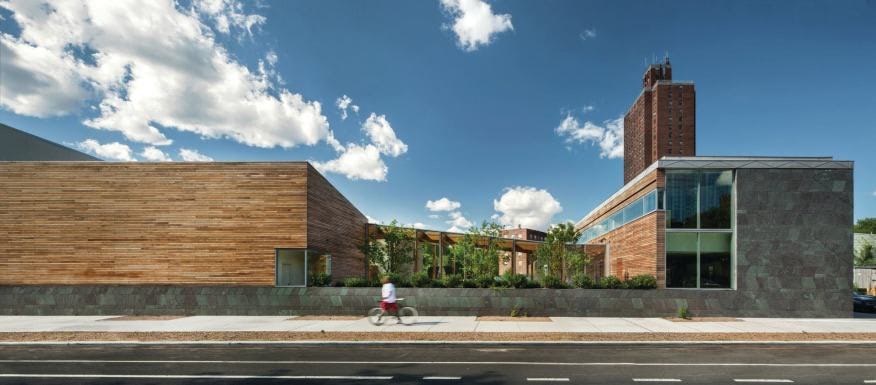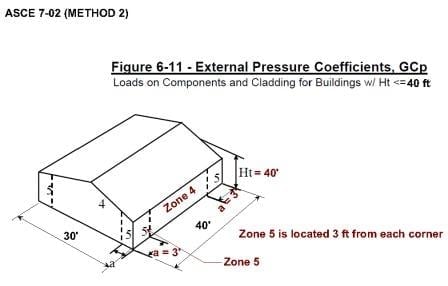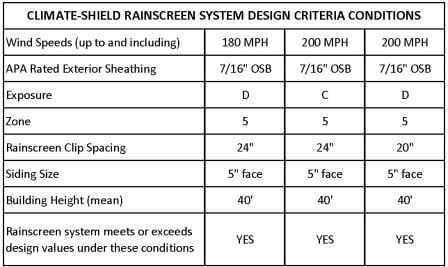
RAINSCREEN DESIGN VALUES
Climate-Shield® Rainscreen System

The Climate-Shield™ Rainscreen Wood Siding System is designed to exceed the worst conditions that nature can throw its way. Engineering studies confirm that the Climate-Shield CS2 Rainscreen Clip System exceeds the performance criteria for winds greater than 200 MPH in a variety of harsh environmental conditions.
The combined strength created by the sturdy design of the Climate-Shield Rainscreen Clips and the fastening power of the stainless steel screws create amazing holding and endurance for the entire rainscreen system. The Climate-Shield rainscreen system is designed to resist the potentially devastating effects of the direct pressure (and suction-like back pressure) created by 180 to 200 MPH wind gusts. Even under the most extreme conditions and harshest exposures, using minimum thickness OSB exterior sheathing, the engineering results demonstrate that the Climate-Shield Rainscreen System will shield and defend your structure against the most grueling punishment nature can throw at it.
For the engineering evaluation, we intentionally went to the worst case scenario conditions.
We chose the lowest strength and thinnest exterior structural sheathing (APA Rated 7/16" OSB) to analyze the strength of the rainscreen system.
We also selected the toughest zone of the structure (outside corners) that is most vulnerable area of a building (noted as Zone 5 in the diagram at the bottom of the page). The outside corner areas are most susceptible to wind and hurricane exposure.
We also used the harshest exposure conditions (Exposures C and D), which includes regions where the effects of wind are commonly the most severe, including coastal hurricane exposure.

The Climate-Shield Rainscreen Wood Siding System is engineered to meet or exceed all the design values in the intense conditions shown above. Even in the face of such harsh conditions, unforgiving climatic exposures, lowest strength exterior structural sheathing, and Zone 5 portion of the structure, the Climate-Shield Rainscreen System meets or exceeds the design criteria in the test conditions.
For an even stronger and more resistant rain screen design you can also:
1.) Use plywood instead of OSB
2.) Use thicker OSB
3.) Use thicker plywood
4) Use narrower width rainscreen siding (more screws equals more holding power).
5) Space the rainscreen clips closer together.
6.) Any combination of the above

Additional information about the design criteria used for the rainscreen engineering studies
-
Exposure C as described in the IRC (International Residential Code) refers to areas that may include some partial obstructions and shoreline areas in hurricane-prone coastal regions.
-
Exposure D in the IRC code is the most severe environmental conditions with exposures that may include open and unobstructed areas such as inland waterway areas, Great Lakes region and coastal regions of California, Oregon, Washington and Alaska (not including hurricane-prone shoreline areas).
-
You can create an even stronger rainscreen configuration by using narrower width rainscreen wood siding. With rainscreen siding narrower than 5”, the rainscreen clips and fasteners are even closer together. This provides even stronger protection for your structure.
-
Using OSB thicker than 7/16" will also improve the screw pull-out strength (and therefore the design values of the rainscreen system).
-
Plywood exterior sheathing has stronger screw pull-out strength than OSB and will provide higher design values for your rainscreen system. Thicker plywood will yield even higher design values in this rainscreen system.
-
Zone 5 refers to the wall area of a structure that is most vulnerable to damage from hurricane and seismic activity and is located on the outside corner of the structures. The design values for the rainscreen system are even stronger in Zone 4 (areas away from the outside corners and closer the center of the exterior wall).
CONTACT OUR TECHNICAL TEAM FOR ADDITIONAL INFORMATION



